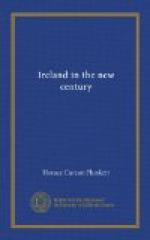[20] See, inter alia, an article “Ireland and America,” by Rev. Mr. Shinnors, O.M., in the Irish Ecclesiastical Record, February, 1902. ‘Has the Church,’ asks Father Shinnors, ’increased her membership in the ratio that the population of the United States has increased? No. There are many converts, but there are many more apostates. Large numbers lapse into indifferentism and irreligion. There should be in America about 20,000,000 Catholics; there are scarcely 10,000,000. There are reasons to fear that the great majority of the apostates are of Irish extraction, and not a few of them of Irish birth.’
[21] This view seems to be taken by the most influential spokesmen of the Roman Catholic Hierarchy. See Evidence, Royal Commission on University Education in Ireland, vol. iii., p. 238, Questions 8702-6.
[22] I may mention that of the co-operative societies organised by the Irish Agricultural Organisation Society there are no fewer than 331 societies of which the local priests are the Chairmen, while to my own knowledge during the summer and autumn of 1902, as many as 50,000 persons from all parts of Ireland were personally conducted over the exhibit of the Department of Agriculture and Technical Instruction at the Cork Exhibition by their local clergy. The educational purpose of these visits is explained in Chap. x. Again, in a great number of cases the village libraries which have been recently started in Ireland with the assistance of the Department (the books consisting largely of industrial, economic, and technical works on agriculture), have been organised and assisted by the Roman Catholic clergy.
CHAPTER V.
A PRACTICAL VIEW OF IRISH EDUCATION.
A little learning, we are told, is a dangerous thing; and in their dealings with Irish education the English should have discovered that this danger is accentuated when the little learning is combined with much native wit. In the days when religious persecution was universal—only, be it remembered, a few generations ago—it was the policy of England to avert this danger by prohibiting, as far as possible,




